HTTPV2 Pagination
- Perform pagination using Query Parameters
- Parameter Name
- Initial Value
- Next Value:
- Increment by constant
- Fetch from last response
- JSON Path Evaluator
- Fetch from last response last record
- Increment by value fetched from last response
- Increment by value fetched from last response last record
- Custom expression
- Persist across run
- Generate URL
- Pagination End Condition
- Last Page Record Count
- Cursor from last page
- Cursor from last record of last page
- Offset Condition
- Total Record Count
- Perform pagination using URL Cursor
- Perform pagination using JSON Body
- Perform pagination using Header
In this article
- Perform pagination using Query Parameters
- Parameter Name
- Initial Value
- Next Value:
- Increment by constant
- Fetch from last response
- JSON Path Evaluator
- Fetch from last response last record
- Increment by value fetched from last response
- Increment by value fetched from last response last record
- Custom expression
- Persist across run
- Generate URL
- Pagination End Condition
- Last Page Record Count
- Cursor from last page
- Cursor from last record of last page
- Offset Condition
- Total Record Count
- Perform pagination using URL Cursor
- Perform pagination using JSON Body
- Perform pagination using Header
Perform pagination using Query Parameters
This help section covers steps to perform pagination by providing Query parameters.
Use this option when the query parameters are changing in the URL.
To generate URLs for pagination condition, provide query parameters by selecting the ADD ROW option.
Follow the process to perform pagination:
Parameter Name
Provide query parameter name that will be used in the URL followed by the Initial value of the query parameter.
Example: page -> This will make the URL as http://www.<url>.com?page=<query_parameter_value>
Initial Value
The initial value of the query parameter should be provided.
Example: 1 -> This will make the URL as http://www.<url>.com?page=1
Options available to select the initial value data types are:
Integer, Double, String, Boolean, Date, Timestamp, Time in Millis.
Next Value:
Provide the options to derive the next value for the parameter using below options.
Example: $.nextpage -> This will make the URL for next call as http://www.<url>.com?page=2
Increment by constant
The initial value provided will be incremented by constant value.
Example:
The Start Parameter’s initial value is 0. This value will be incremented by 20.

Fetch from last response
Based upon the API, the value of the start parameter will be picked from the last response.
Example:
If the last response is:

Then, the start value will be 20 and the expression will be $.meta_data.start as shown in the JSON Path Evaluator.
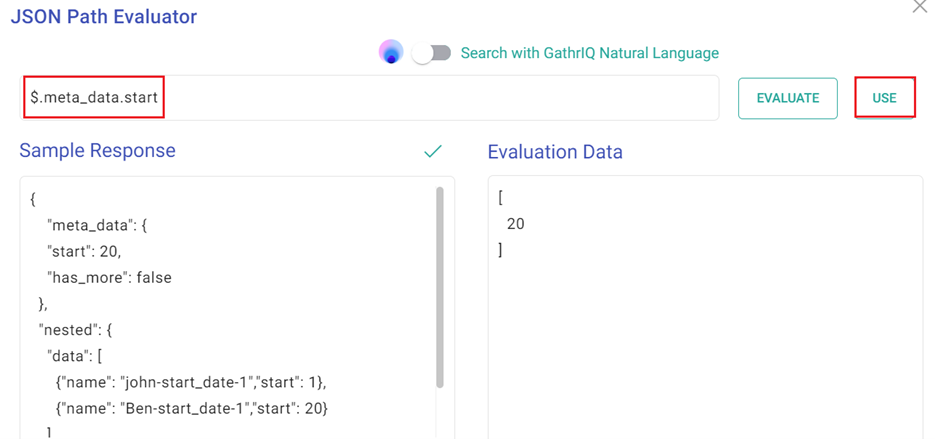
JSON Path Evaluator
Use the JSON Path Evaluator
Provide a sample JSON response.
Navigate to the specific key of the JSON, click on it for the path to appear on the search bar.
Option to write the path in the search bar is available. Click the EVALUATE button for path evaluation. If the path and provided JSON are correct, then the evaluated data will appear in the Evaluation data section.
Option to use Gathr natural language is available. Enable the toggle button to generate the path.
Fetch from last response last record
The data will be picked from the last response’s, last record.
Example:
If below json is the last response, the data will be picked from last response’s last record i.e., $.start in this case.


Increment by value fetched from last response
The current value of the parameter will be incremented from the last response.
Example:
If start initial value is 0 and the value from given path is $.meta_data.start then the next value will be 0+20 i.e., 20. And the next value incremented will be 40.
{
meta_data: {
start: 20,
has_more: false
}
}
Increment by value fetched from last response last record
The current value of the parameter will be incremented from the last response’s last record.
Example:
If start initial value is 0 and the value from given path is $.start then the next value will be 0+20 i.e., 20. And the next value incremented will be 40.
{
meta_data: {
start: 20,
has_more: false
}
}
Custom expression
Option to write spark custom expression.
Example:
CAST(get_json_object(last_response_last_record, “$.id”) AS int)
You can enable the Persist across run checkbox to retain the last offset value as the initial value for the subsequent run.
Using Current Date
Example:
Customize the Initial Value selected as Date.
To assign a custom date of the parameter value, select the initial value as Date by providing date format like yyyy-dd-mm and Next Value as Using Current Date option.
Assign a custom date by selecting the Edit option as shown below.
Options to add to current date or subtract to current date to derive custom value are available.

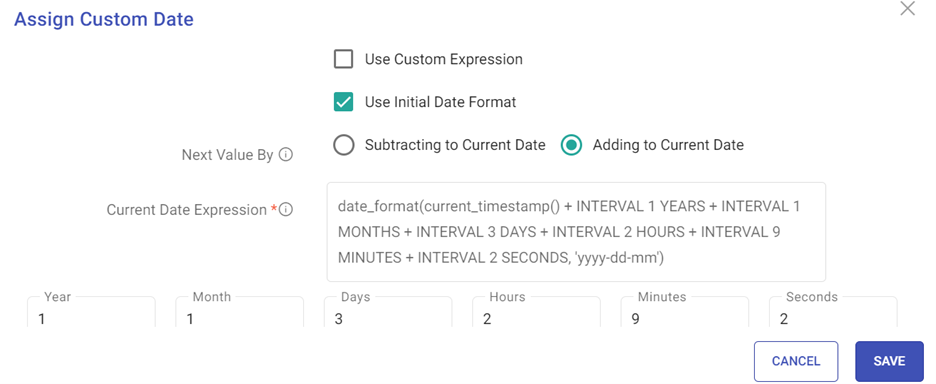
Persist across run
Enable the checkbox to retain the last offset value as the initial value for the subsequent run.
Generate URL
This option is used to validate the provided configurations. If the provided configurations are provided acurately then it will generate a curl.

Pagination End Condition
Provide Pagination End Condition. To achieve so, click the ADD RULE button.
Example:
Last Page Record Count
If this option is selected, then the pagination end condition will be applied to the last record count of the page.

Cursor from last page
If this option is selected, then the pagination end condition will be like $.meta_data.start. When the $.meta_data.start value will be 60, then the pagination will stop.

Cursor from last record of last page
If this option is selected, then the pagination end condition will be applied to stop at last record of the last response.
Example:
If this option is selected, then the pagination end condition will be like $.meta_data.start. When the $.meta_data.start value will be 60, then the pagination will stop.

Offset Condition
The offset name which has been used in the parameter section should be provided that can be used in the Custom Expression and Pagination End Condition expression.
Example: Read till start where pagination will stop when the start value will be less than 60.
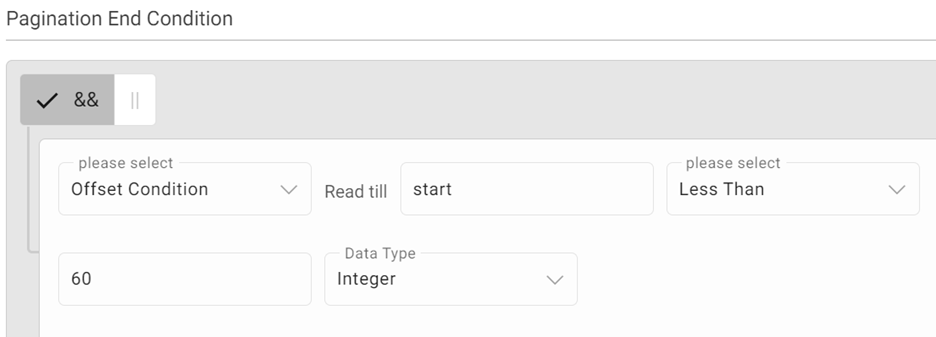
Total Record Count

The pagination end condition applied to select url Cursor from last page. Stop when attribute from last response is selected.
Based on the above selected conditions click the Generate CURL option to generate the links.

You can also provide Timeout option to set a timeout and stop fetching data from paginated calls by terminating the application after the specified time interval (in seconds).
Enable Request Rate to Control the rate at which pagination requests are made.
Example:
Make 50 requests in 10 seconds, on throttle exception wait for 60 seconds.
Perform pagination using URL Cursor
This help section covers details on how you can perform pagination using HTTPV2 by providing URL Cursor parameters.
There are 3 ways by which Url for subsequent page request can be done.
These options available in the drop-down are:

Assign URL. This option lets you assign a customized URL. Example: concat($url,"?page=5").
Fetch from last response
For Example:

- Fetch from last response last record
For Example:

Generate URL
This option is used to validate the provided configurations. If the provided configurations are provided acurately then it will generate a curl.

Likewise, provide the Pagination End Condition
Perform pagination using JSON Body
Pagination can be performed using JSON Body parameters.
This option is available for use when Request method is selected as POST.
Provide the JSON path key.
Provide Initial Value.
Based on the API, select the Next Value.
Assign Pagination End Condition.
Generate CURL value. This option is used to validate the provided configurations. If the provided configurations are provided acurately then it will generate a curl.

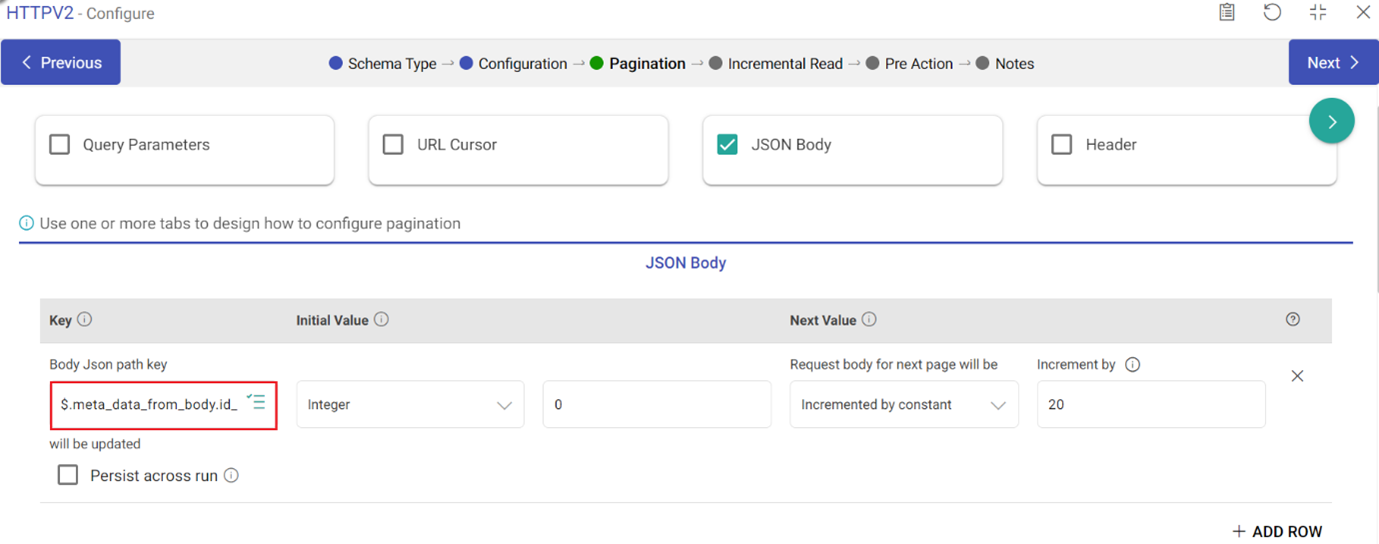
Perform pagination using Header
Pagination can be performed using Header parameters if the API to be used contains header.
Provide the key value and initial value.
Based on the initial value selected, choose an option from the Next value by which pagination must be performed.
The available options are as follows:

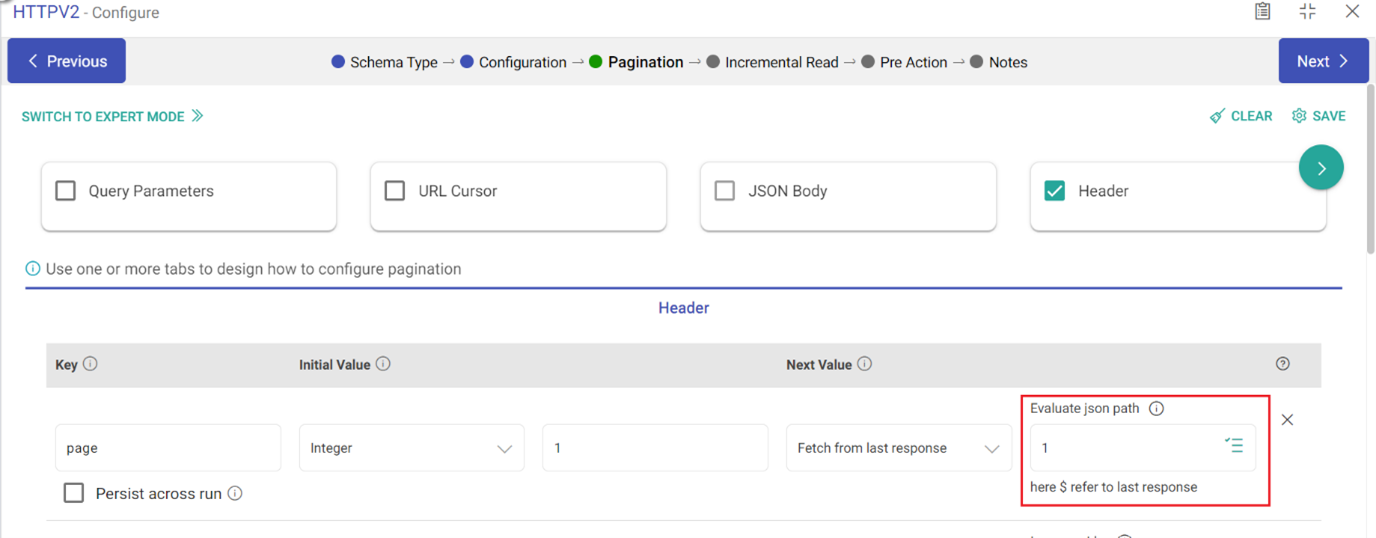
If you have any feedback on Gathr documentation, please email us!